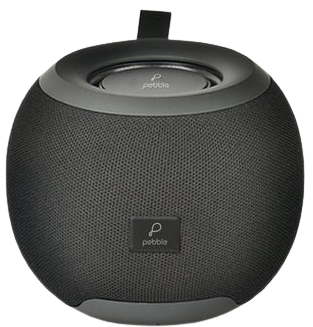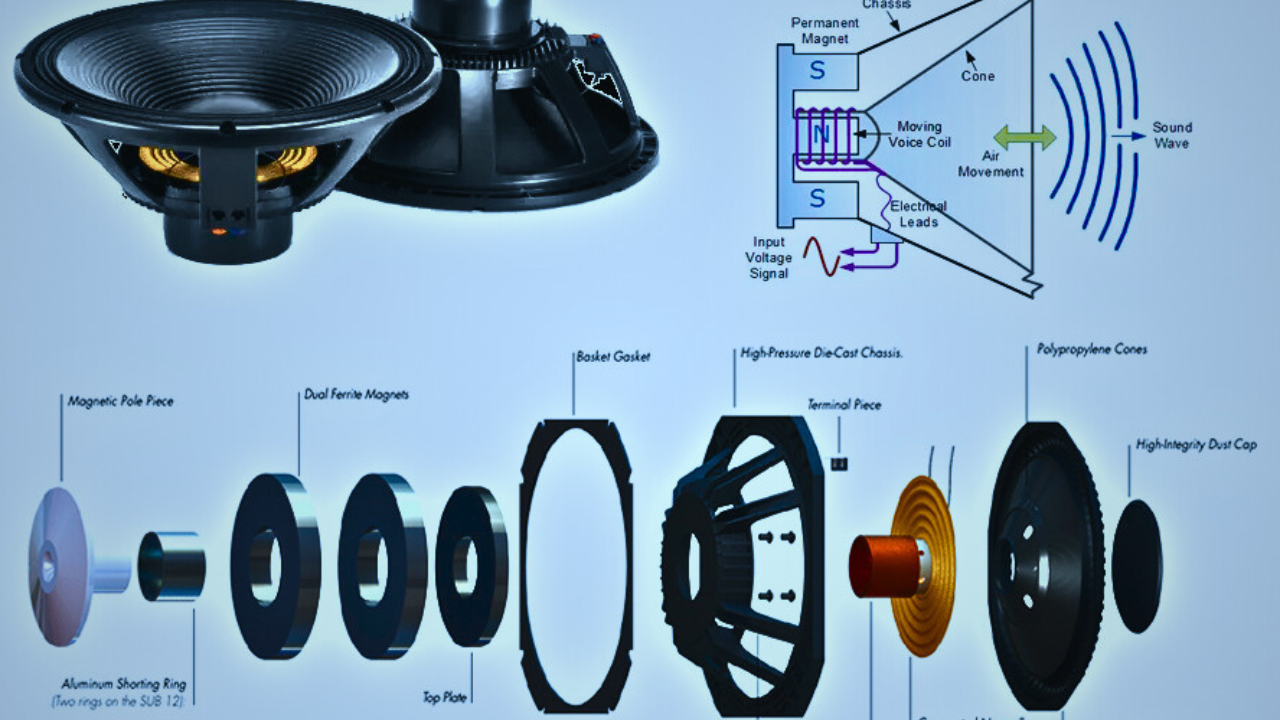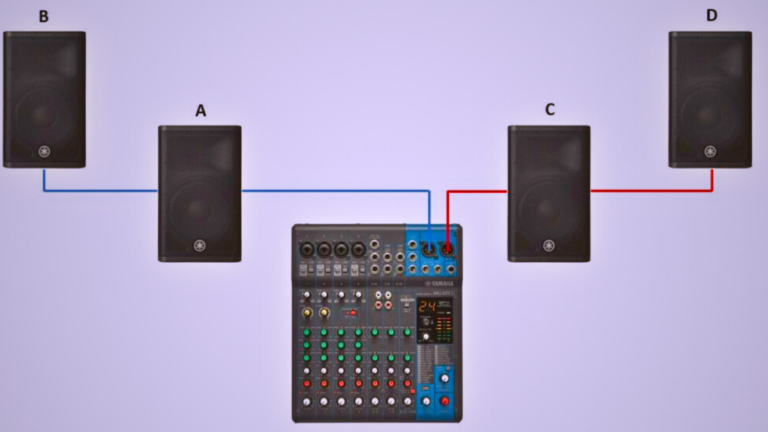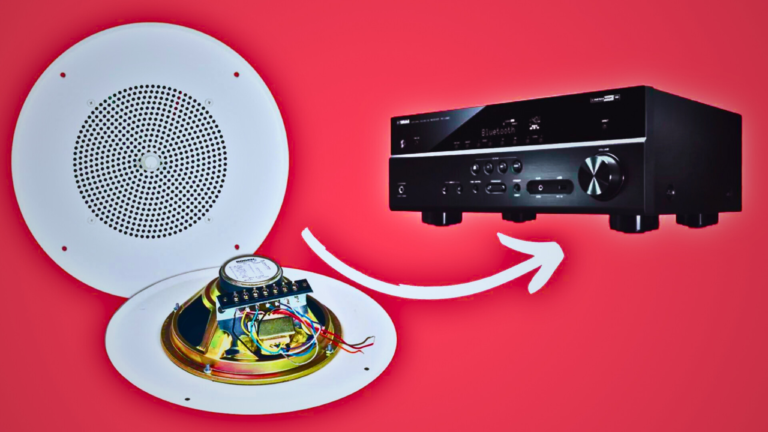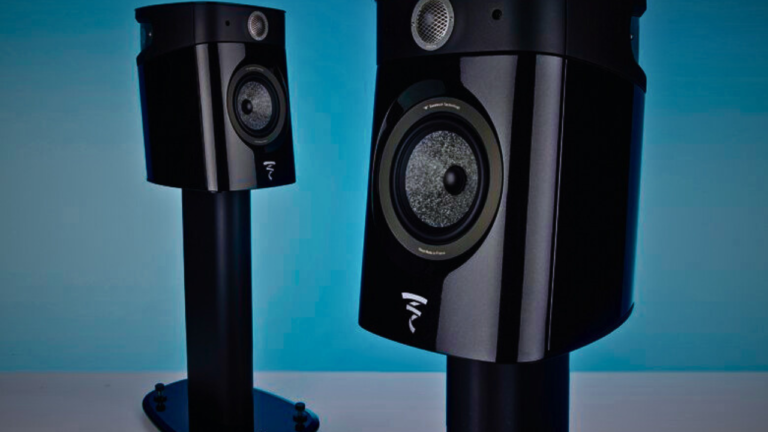Why Are Magnets Used In Speakers To Form A Sound?
The speaker is a technical marvel that relies heavily on magnets. Speakers skillfully illustrate how commonplace and essential magnets are to our everyday lives. Ever ponder why magnets are used in speakers? The utilization of magnets in this mechanically small but technically stunning gadget is a marvel of science and human creativity, a confluence of sound design and physics.
Fundamentally, the process of converting an electrical signal into audible sound—which calls for a thorough understanding of sound waves, a dash of electromagnetism, and a sprinkle of mechanics—depends on the magnets in speakers.
The sound quality and volume that emanate from your speaker are greatly influenced by the magnetic field that is created inside of it. The electromagnetic motor’s core, the magnet, pushes the speaker cone back and forth to create sound waves that are perceived by people as a beautiful symphony or a powerful bass.
“In a speaker, the magnet forms the heart of an electromagnetic motor, which drives the speaker cone back and forth, producing the sound waves that reach our ears.”
To understand the intricacies of this process, let’s investigate it a little further. When electricity passes through a coil, an electromagnetic field is created around it. The voice coil, which is coiled around the speaker’s core, is usually situated near the magnet.
The coil and accompanying cone move swiftly back and forth due to fluctuations in the field, which is why sound is created when an electrical signal is sent to the speaker, according to the rules of electromagnetics.
- Step 1: An electromagnetic field is created around the voice coil by an electric current that it receives.
- Step 2: The permanent magnet near the coil interacts with the magnetic field it generates to produce a magnetic force.
- Step 3: This magnetic force pulls and pushes the coil, which causes the associated speaker cone to move.
- Step 4: As the speaker cone travels, sound waves are created, which cause the air to vibrate in a specific way.
Thus, it is clear how important a role the seemingly innocuous magnet plays in creating the soothing music to which we so often listen when eating, sleeping, and breathing. Remember magnets’ silent but essential part in giving you a pleasing sound experience the next time you lose yourself in music emanating from your speakers? Magnets are the perfect combination of electromagnetics and sound in a captivating performance.
Read also: Why Do Speakers Have Magnets?
What are the essential components of a speaker?
A speaker, also known as a loudspeaker, is a device that converts electrical information into audible sound by using several interconnected elements. The surround, diaphragm, voice coil, magnet, and basket are some of these crucial components.
1. A magnet
The speaker’s magnet, which is often permanent, is a tactical component with several uses. Primarily, the magnet generates the necessary magnetic field for the speaker to operate. This magnetic field interacts with the amplifier’s current, causing the voice coil to vibrate.
2. Voice Coil
The loudspeaker’s core is the voice coil. It consists of a coil of wire that is frequently looped around a bobbin. It moves exactly in response to the magnet’s electromagnetic field, which is converted to sound.
3. Diaphragm or Cone
The diaphragm, or cone, which is directly connected to the voice coil, is at the forefront of this intricate ensemble. This part moves air to create sound waves by using the mechanical energy from the vibrating voice coil. The diaphragm serves as the speaker-listener interface, which is vital.
4. Basket Supports And Houses
The voice coil, magnet, and diaphragm are all housed and supported by the basket. It acts as the “skeleton” of the speaker, holding the entire moving assembly together and providing the necessary rigidity and sturdiness to the system.
The surround, which is usually composed of rubber, foam, or linen, helps the diaphragm move. Without overly dampening the system, it offers recovery force and the entire diaphragm excursion range.
How does a speaker’s magnet work?

The magnetic field of the voice coil is primarily formed by a magnet, which is essential to a speaker’s operation. Essentially, the magnet is inserted surgically into the speaker’s structure and is usually protected by a metal basket. Its primary function is to provide a steady, uniform magnetic field.
Energy Portal
The voice coil of the speaker and the magnet live together as a powerful energy portal. It’s interesting to note that this voice coil produces a secondary magnetic field when an electrical signal is delivered through it. A push-pull movement results from the inevitable interaction between this and the magnet’s.
Repeated Action
These alternating magnetic fields cause a repeating motion that precisely stimulates the diaphragm, or cone attached to the voice coil. The diaphragm’s cyclic recoil and reaction, which reflect signal fluctuations, are essential for transforming electrical energy into mechanical energy. The diaphragm’s tremors are then converted into changes in air pressure, which produce the same appearance of sound that humans hear.
The Speaker’s Function
As the center of the speaker’s operation, the magnet produces a steady magnetic field that enables reliable and strong sound output. As such, it plays a crucial and unquestionably laborious part in the dynamics of speaker functionality.
What is the scientific basis for the sound that magnets produce in speakers?
- An audio signal, or input, is where it all starts. An electrical representation of sound waves is called an audio signal. The changes in sound waves are reflected in the variations in the electrical signal.
- An electromagnetic field is created around the voice coil as the audio signal passes through it. This modifies the voice coil’s polarity, causing it to attract and repel the magnet in turn.
- The voice coil pushes and pulls on the diaphragm or cone of the speaker, vibrating the air and producing sound waves that our senses interpret as sound.
- The speed at which the speakers reproduce sound is so high that it surpasses the frequencies of the audio signals. For example, the diaphragm vibrates 1000 times per second when an audio signal is received at 1000 Hz.
- The type, size, and strength of the magnet also affect how well the speaker sounds. A louder and clearer sound can be produced by pushing the diaphragm further with larger and stronger magnets.
- Strong magnetic fields found in speakers help to reproduce sound precisely, making sure that every little detail in the audio signal is faithfully translated into sound.
Why do sound producers choose to use magnets?
Because of a variety of characteristics that make them essential components in sound creation, magnets have been extensively used in speaker design for a long time. One must go deeply into the fundamental characteristics of magnets and their smooth integration into the intricate workings of the acoustic universe in order to fully understand the reasoning behind this masterful reliance.
| Reason | Description |
|---|---|
| High Efficiency | Magnets, in particular, render the operative mechanism of speakers highly efficient, allowing for the consistent delivery of high-quality sound. |
| Sound Manipulation | Utilizing magnetic phenomena, speakers can manipulate the sound to produce diverse audio outputs, contributing to an overall better listening experience. |
| Cost and Availability | Given their relatively low cost and wide availability, magnets are economically viable for use in speaker manufacturing. |
| Durability | Magnets demonstrate a high degree of resilience and long-lasting properties, which is vital for a device like a speaker that is in constant use. |
| Size Flexibility | Magnets can be crafted into various sizes to fit the diverse requirements of different speaker models, all while maintaining their magnetic properties. |
In summary, the speaker industry’s preference for magnets stems from their capacity to generate a strong magnetic field, provide remarkable durability, and ensure accuracy in sound reproduction.
These characteristics work in unison to improve speakers’ audio output, making magnets’ contribution to sound generation indispensable. This explains why magnets end up being the clear favorite when it comes to selecting parts for sound creation.
Read also: What Amp Do I Need For 100W Speakers?
Which kinds of magnets are utilized in speakers?

Different kinds of magnets are used by the audio equipment business nowadays to build speakers. Magnets made of ferrite, neodymium, samarium cobalt, and alnico are a few examples. Any given situation has a number of factors that affect the point of decision, including financial concerns, the speaker’s physical limitations, and the particular goals for audio quality.
1. Magnets Alnico
Originally created in the 1940s, alnico magnets quickly rose to prominence as the material of choice for speaker magnets. The abbreviation Alnico refers to an alloy consisting of aluminum (Al), nickel (Ni), and cobalt (Co).
The reason Alnico is valuable is because of its strong magnetic field and incredible thermal stability, which, when used in speakers, produce a smooth, “vintage” sound. But in comparison to its counterparts, it is more expensive, which has made it less popular recently.
2. Magnetic Ferrite
Because it is far less expensive than alnico, ferrite, sometimes referred to as ceramic magnets, has become the preferred material in the industry. Iron oxide and other chemical substances are used to make it. Ferrites are an attractive option for mass-produced audio equipment since they are reasonably priced and useful, while not having the same level of thermal stability and magnetic field strength as Alnicos.
3. Third, Neodymium Irons
Compared to alnico and ferrite, neodymium is a rare-earth magnet with a stronger magnetic field. It is therefore the best option for compact, powerful speakers. In addition, it lightens the speaker considerably and is reasonably priced despite its uncommon name. Nevertheless, Neodymium magnets lack Alnico’s thermal stability, so a heat management mechanism inside the speaker is required.
4. Cobalt-Samarium Magnets
Another type of rare-earth magnet is samarium cobalt, which combines the exceptional magnetic field strength of a neodymium magnet with enhanced thermal stability similar to that of an Alnico magnet. Samarium cobalt is used in some premium speakers to attain exceptional performance. But keep in mind that it is the priciest of these four types of magnets and is employed less commonly because of financial reasons.
In summary
In summary, the use of magnets in speaker design and operation is a monument to human inventiveness and an excellent example of how science and beauty can come together to create a wonderful technical marvel. Magnets are at the forefront of sound production technology because of their capacity to transmit energy, support repetitive motion, and produce overall high-quality, resonant sound.
Speaker magnets have a major role in the richness and purity of sound produced by audio equipment, which influences how we as a society perceive audio-visual, voice, and music. Their vital function serves as proof of the intensive research and development that keeps improving their efficiency and adaptability.
It’s interesting to see the exciting scientific ideas underlying such a widely used gadget, in fact. Speakers, in particular, the function magnets play in their operation and the various varieties of magnets and their unique applications encourage us to recognize the enormous amount of human achievement in the things we do on a daily basis.
The fact that a seemingly insignificant item like a magnet can be precisely designed to vibrate and produce sound waves that humans interpret as speech or music is nothing short of astounding.
As a proud tribute to our scientific prowess and pursuit of excellence, sound travels from an electrical signal to an audible wave, propelled by the aesthetic and scientific properties of magnets used in speakers. Therefore, let’s not just observe but also be in awe of this amazing confluence of science and art as we learn the story of magnets in speakers.
Read also: Can You Run 4 Ohm Speakers At 2 Ohms?
FAQs
Why are magnets necessary for speakers to operate?
It would be difficult to convert an electric signal into sound in speakers without magnets. The voice coil and magnets work together to push and pull the diaphragm, producing the sound waves that humans recognize as sound. Magnets are a crucial component of the motor construction of the speaker.
Can materials other than magnets be used in speakers?
It is conceivable in theory, but the sound produced would be far less effective and of lower quality. Due to their unique characteristics, magnets are effective in transforming electrical energy into kinetic energy, which is a necessary step in the creation of sound in speakers.
What controls the magnet’s strength in a speaker?
A speaker’s magnet strength is determined by several factors, such as the speaker’s size and intended use . Stronger magnets are needed for larger speakers, such as those found in professional audio systems, which are designed to produce loud, high-quality sound.
What would happen if a speaker employed a stronger magnet?
The electromagnetic field generated between the magnet and the voice coil gets greater when a stronger magnet is utilized. This increases the speaker’s effectiveness and may enhance the sound quality. To prevent distortions or damage, the stronger magnet must be taken into consideration in the entire speaker design.
Does a speaker’s type of magnet impact the quality of sound it produces?
Indeed, speaker performance and sound quality can be impacted by the type and quality of the magnet . Neodymium magnets, for example, are perfect for small, high-quality speakers because of their extraordinary power relative to their size.
Do speaker magnets come in a uniform shape?
No, speaker magnets are not limited to one shape. The most popular design is a ring- or donut-shaped magnet, which makes it simple to position the voice coil inside the magnetic field.
Can the shape of a magnet influence the speaker’s sound quality?
The shape of a magnet doesn’t directly influence the sound quality. However, the shape can affect how well the magnet fits into the speaker design, which can indirectly impact the efficiency and sound quality of the speaker.
Do speaker magnets eventually lose their magnetic properties?
The magnets in speakers are permanent and do not lose their magnetism under typical conditions. However, a speaker magnet may gradually lose some of its magnetism in extreme situations like heat and shock.
How long do speaker magnets last?
Typically, speaker magnets are made to endure for the same amount of time as the speaker. A speaker’s magnet should remain efficient and magnetized throughout the duration of the speaker’s operation, barring harsh circumstances or overuse.
Are the magnets in speakers a cause for concern for safety?
Under typical use, speaker magnets are typically safe. But they could be dangerous if ingested or if they come into direct contact with electronics. Make sure they are placed correctly and kept out of children’s reach.

Hey there! I’m Henry Jack, the voice behind speakerrealm.com, your ultimate destination for everything speakers. Whether you’re a seasoned audio enthusiast or just starting to explore the world of sound, you’ve come to the right place.
At Speaker Realm, I dive deep into the realm of speakers, bringing you comprehensive reviews, insightful guides, and the latest trends in the industry. From floor-standing behemoths to compact bookshelf wonders, I cover it all.
I’m passionate about helping you find the perfect speakers to elevate your audio experience. Whether you’re setting up a home theater, upgrading your sound system, or just looking for some quality audio gear, I’ve got you covered.
But Speaker Realm isn’t just about technical specs and performance metrics—it’s also about the art and science of sound. I explore topics like acoustic design, speaker technology, and the impact of audio on our lives.
So whether you’re a casual listener or a hardcore audiophile, join me on this journey through the world of speakers. Let’s turn up the volume and explore the endless possibilities of sound together at speakerrealm.com!
